Mastering Drone Filming for Surfing Adventures
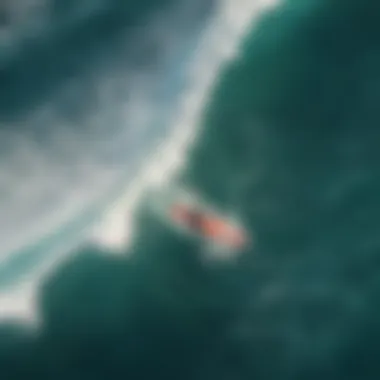
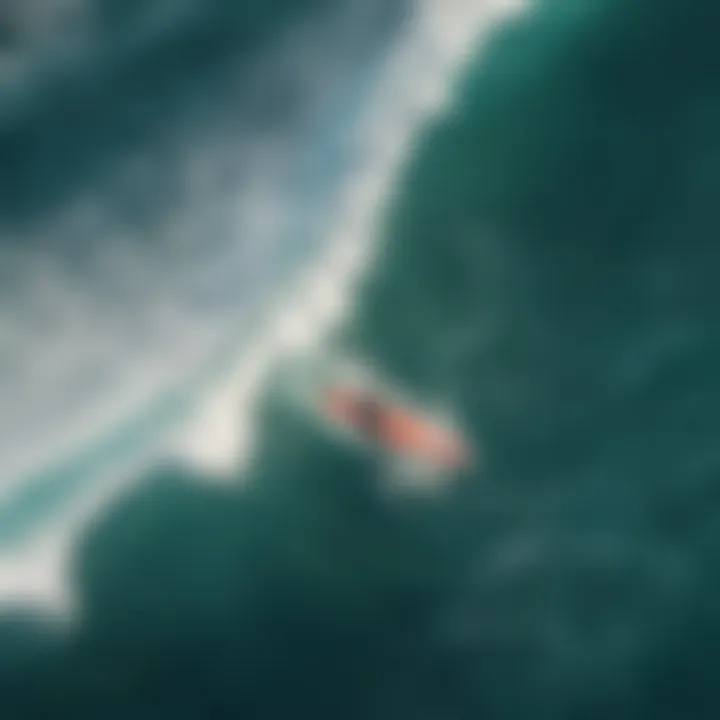
Intro
Drones are shaking up the way we think about capturing the thrill of surfing. No longer confined to shaky handheld shots or mundane beach views, these flying machines can provide stunning aerial perspectives that tell a richer story. As a surfer, capturing your rides from above adds a whole new layer to the experience, not just for you but for your audience as well. Whether you're a budding enthusiast or a seasoned pro looking to elevate your filming game, understanding how to effectively use drones in your surfboarding adventures is essential.
This guide dives into the nitty-gritty of drone filming tailored just for surfing enthusiasts. From technical details like equipment choices to the artistic angles that will make your videos pop, we cover it all. You’ll learn about the legalities that come with flying drones along the coast, the creative techniques to shoot action-packed footage, and tips for editing your clips into a masterpiece that resonates with viewers. Together, we’ll unlock the potential of aerial imagery to heighten the storytelling capabilities of surf culture.
So, grab your controller and your board—let’s get set to explore the wave-riding world from an exhilarating new vantage point.
Surfboarding Techniques
When it comes to capturing the essence of surfing, the footage you shoot can vary significantly based on the techniques you're employing on the water. Understanding the riding styles and skills can help provide context to the aerial shots you capture. Here's how:
Beginner Tips for Mastering the Basics
If you're just starting out with surfing and drone filming, keep it simple. Begin by focusing on the fundamentals of both activities.
- Choose safe conditions: Start on calm days with smaller waves. This way, you can focus on your technique without worrying about heavy swells.
- Work with gradual shots: Even if you don’t have top-of-the-line drones, drone camera angles can enhance your videos. Get stable shots by keeping the drone a safe distance while you ride a wave.
- Practice with various angles: Fly lower at first to capture the splash and the vibe of the ocean without losing sight of your board. Aim to capture the action parallel to the waves rather than directly overhead.
Advanced Techniques for Seasoned Surfers
For the more experienced surfers, the key is to find creative expressions and exciting new angles in your videos.
- Dynamic maneuvers: When you're pulling off tricks or taking off on bigger waves, make sure the drone follows your movements fluidly. This engages the viewer and captures the adrenaline of your ride.
- Diverse settings: Explore different locations to film. Different beaches and surf spots can provide varied backgrounds, from rocky coastlines to sandy shores. This adds depth and richness to your footage.
- Timing with waves: Syncing your aerial shots with the ebb and flow of the waves will amplify the beauty of the captured moments. Time your drone flights during the bigger sets to get the best angles.
"A drone isn’t just a camera in the sky; it’s a ticket to new storytelling realms that invites viewers to experience surfing in ways they’ve never imagined."
By mastering these techniques, surfers can elevate their filming game, ensuring that each ride captured on film tells its own compelling story.
Surfboard Equipment
While drones capture stunning footage, what about the surfboards and equipment you’re using? It’s vital to have the right gear to enhance performance while riding the waves.
Essential Gear for Every Surfboarder
- Wetsuits: Especially in colder water, ensure you invest in a high-quality wetsuit that offers warmth without restricting range of motion.
- Leash: A robust leash is crucial for keeping your board close, particularly when filming. You don’t want your board drifting off while you’re focused on showcasing a killer wave.
- Fins: Choose fin setups that suit your skill level and the type of waves you’re riding. The right fins improve control and maneuverability in the water.
- Proper Footwear: If you’re surfing in rocky areas, consider surf booties. They help protect your feet and maintain grip on your board.
Reviews of the Latest Surfboards on the Market
In a world where brands are myriad, keeping up can be daunting. Look for boards that are known for not only their performance but superb design and functionality. 🏄♂️ Some options to consider include:
- Firewire Surfboards: Innovative materials and eco-friendly designs make their boards incredibly responsive.
- Lost Surfboards: Renowned for performance, their boards are shaped for maneuverability and speed.
- Channel Islands: A long-standing favorite among pros, their boards feature cutting-edge technology that enhances every ride.
As the surfing world evolves, having the right gear that complements both your skills and your filming ambitions is vital. While you’re out there catching waves, don’t forget to capture the ride—because every wave tells a story, and with drones, yours can reach new heights.
The Evolution of Aerial Filming in Surfing
Aerial filming in surfing has undergone a remarkable transformation over the years. Capturing the exhilarating dynamics of the ocean, with surfers weaving through the waves, has always piqued the interest of filmmakers, athletes, and enthusiasts alike. The evolution of this craft speaks to larger shifts in technology and perspective. With each advance, not only has the storytelling possible in surf culture grown richer, but also the relationship between the surfers and their environment has deepened.
Early Beginnings of Surf Filming
The inception of surf filming can be traced back to the early 20th century, when simple handheld cameras first started to record surfers in action. Most of these early films were shot from the beach, limiting the visual storytelling to flat, ground-level perspectives. Grainy images captured the sport, but they hardly conveyed the full scale of nature's power or the thrill felt by the surfers. One notable instance is the work of George Greenough, who innovated by filming from within the waves. Using a homemade rig that allowed him to shoot underwater, Greenough introduced audiences to a new visual language of surfing. His creativity paved the way for others, inspiring a generation of filmmakers to think outside the box.
The Shift to Drone Technology
Fast forward to today, and the introduction of drone technology revolutionized aerial filming. Unlike its predecessors, drones can achieve heights and angles that were once logistically impossible or prohibitively expensive. For instance, a drone can hover over a surf break, capturing intricate details of a surfer’s technique and the wave’s shape simultaneously, all while remaining agile and unobtrusive. Drones equipped with high-definition cameras can follow the action, delivering dramatic, immersive footage that lets viewers feel the rush of cutting through waves like never before.
The flexibility of drones enables filmmakers to explore creative possibilities that speak volumes about the surfers' experiences in the ocean. It provides the chance to capture stunning top-down perspectives that reveal the choreography of surfers dancing with waves, turning each session into a flowing narrative.
"With the beauty of drone technology, we can see how each surfer interacts with nature in such real-time ways. It’s like watching a dance unfold on an ever-changing stage.” - An inspiring quote from a notable surf filmmaker.
As this technology continues to evolve, so too does the potential for filming. The integration of advanced stabilization systems and high-quality camera sensors means filmmakers can push boundaries further, crafting visuals that resonate deeply with audiences. As drones take to the skies, they not only capture the essence of surfing; they are fast becoming an integral part of the sport's visual identity.
Understanding Drone Technology
Drone technology has revolutionized the way surfers and filmmakers capture the essence of surfing. Understanding this technology is crucial for anyone looking to elevate their filming game. It involves recognizing different types of drones, knowing their features, and selecting the right tools for effective storytelling. Having a grasp on these aspects provides a solid foundation for creating compelling visuals that resonate with an audience.
Types of Drones for Filming
Quadcopters
Quadcopters are the go-to choice for many drone enthusiasts, particularly in the field of surf filming. Their hovering capabilities and agile maneuverability make them exceptionally well-suited for capturing surfers in action. Unlike other types, quadcopters can stay positioned for extended periods, allowing for those stunning close-ups of riders gliding atop waves. A key characteristic is their four rotors, which not only help with stability but also enable precise movements that could be difficult with fewer rotors.
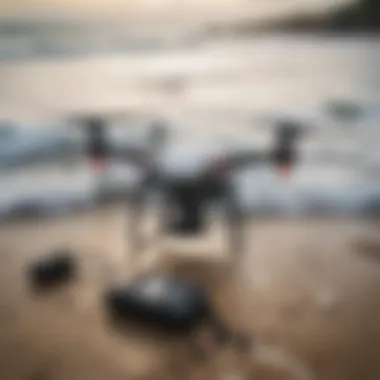
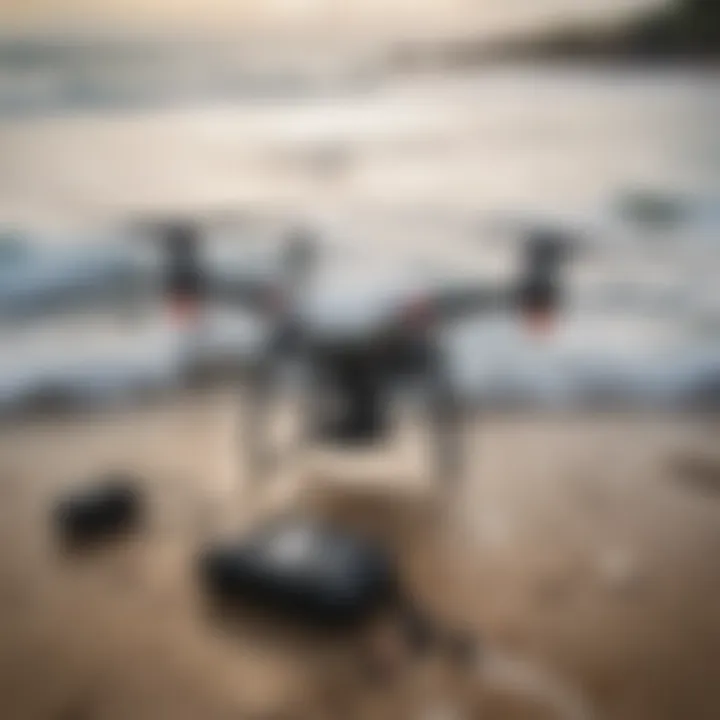
However, quadcopters do have some limitations, particularly in terms of flight time. The need for frequent battery changes can be somewhat inconvenient, especially during expansive shooting sessions.
Fixed-Wing Drones
In contrast, fixed-wing drones offer a different flavor of aerial filming. They are typically built for long-range flights, making them ideal for expansive stretches of coastline. The key feature of these drones is their resemblance to traditional aircraft, which allows them to fly faster and cover greater distances without needing to return to the ground for a battery change. This becomes particularly useful for capturing surfer movements across a wide looming backdrop.
However, fixed-wing drones may not be suited for intricate maneuvers. Their inability to hover means they might miss the smaller, more stylish surfing moments. This trade-off is important to consider when choosing the right drone for specific filming needs.
Hybrid Drones
Hybrid drones take the best of both worlds, combining the capabilities of quadcopters and fixed-wing drones. They can take off vertically like quadcopters but transition into horizontal flight for covering larger areas. This versatility allows filmmakers to execute both detailed shots and expansive views seamlessly.
The unique feature of hybrid drones is this dual mode of operation, allowing them to adapt based on the scenario. Still, they can be more complex to operate and may come with a heftier price tag. For surfers looking to capture all angles of their performance, hybrid drones present both opportunities and challenges.
Essential Drone Features for Filming
Camera Quality
Camera quality is perhaps one of the most critical aspects in drone filming. A high-resolution camera not only offers clear visuals but also enhances storytelling through detailed imagery.
The key characteristic of camera quality is its capability to capture high-definition footage, which has become a crucial element for surf films aiming to show every spray and swell. With the technology today, opting for a drone that can film in 4K or higher will greatly benefit your projects, as it provides flexibility in post-production editing.
One downside is that higher quality cameras can add to the overall weight, impacting flight time and maneuverability.
Stabilization Systems
Another significant feature is the stabilization system. Good stabilization minimizes shakiness, resulting in smooth footage that can do justice to the beauty of surfing. The key aspect here is the gimbals, which are mechanical devices that help stabilize the camera during flight.
Investing in drones equipped with advanced stabilization technology creates a much more professional-looking final product. Nevertheless, these sophisticated systems may require a learning curve, meaning you might face a bit of a challenge initially.
Flight Time
Finally, flight time is crucial to consider. Longer flight times mean more footage and less time spent changing batteries. A key characteristic is how many minutes a drone can stay airborne, generally ranging from 20 to 40 minutes depending on the model.
While extended flight times can be advantageous, it's essential to keep in mind other factors like weight and camera quality that might impact this duration. Ensuring the right balance will help capture the most stunning surfing visuals without interruption.
The right drone can bring your surf films to life, capturing each moment from breathtaking angles and providing a new perspective on the sport.
Overall, understanding these elements of drone technology lays the groundwork for making informed decisions that could greatly enhance the storytelling potential inherent in surf filming.
Choosing the Right Equipment
When it comes to filming surfing, the equipment you choose can make or break your aerial shots. Selecting the right drone and accessories is crucial to capturing those breathtaking moments from above. It isn’t just about having a fancy gadget; the right tools can help you express your vision in ways that resonate with viewers. If you’re serious about bringing an artistic touch to your surf footage, understanding your options and what features matter is key.
Recommended Drones for Surf Filming
When picking a drone specifically for surf filming, there are a few models that consistently stand out among the crowd. Top contenders include the DJI Mavic Air 2, Autel Robotics EVO Lite, and the Parrot Anafi. These drones come packed with features that enhance the filming experience, from exceptional camera quality to superior flight times.
Setting aside the hype around newer models, sometimes it’s the tried-and-true configurations that make a difference. For instance, the DJI Phantom 4 Pro might not be the latest model, but its robust build and reliability on windy days by the seaside make it an invaluable option.
Accessories for Enhanced Filming
Accompanying your drone with the right accessories can elevate your surf films to new heights. Here are some essential additions you should consider:
Filters and Lenses
Adding filters and lenses can completely change the way your footage looks. Polarizing filters can reduce glare from the water, bringing out the vibrant colors of the ocean. This enhancement is especially effective when shooting in the bright sun, where reflections can diminish visibility.
One notable lens type for surf photography is the ND (Neutral Density) filter. This allows you to shoot in bright conditions while maintaining the desired shutter speed to create dynamic shots, capturing fluid motion without the harsh glare.
- Key characteristic: Helps in managing light for cleaner shots.
- Unique feature: Some lenses can also improve depth perception, making waves look even more profound and stunning.
- Advantages: Improved image quality; Disadvantages: May require on-location adjustments based on changing light conditions.
Extra Batteries
Battery life can be one of the biggest letdowns when filming with drones, especially in the active environment of surfboarding. Bringing extra batteries ensures you're ready to capture every wave without cutting your session short.
- Key characteristic: Quick swaps can give you the flexibility to film longer.
- Unique feature: Some brands offer high-capacity batteries that can double your flight time.
- Advantages: More filming time; Disadvantages: Additional cost, but a worthwhile investment for serious filmmakers.
Carrying Cases
Protecting your gear while you're on the go is essential. A good carrying case is a must-have for transporting your drone and accessories. Whether you’re trudging through the sand or navigating rocky shores, a well-designed case can keep everything intact.
- Key characteristic: Durable materials to withstand outdoor adventures.
- Unique feature: Many cases come with custom compartments to keep your gear organized.
- Advantages: Enhanced protection against bumps and drops; Disadvantages: Can take up space in your vehicle, but necessary for safeguarding your investment.
"Choosing the right equipment is not just a matter of preference; it's about enhancing your storytelling capabilities and creating stunning visuals that resonate with your audience."
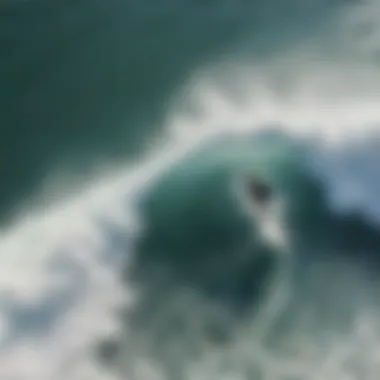
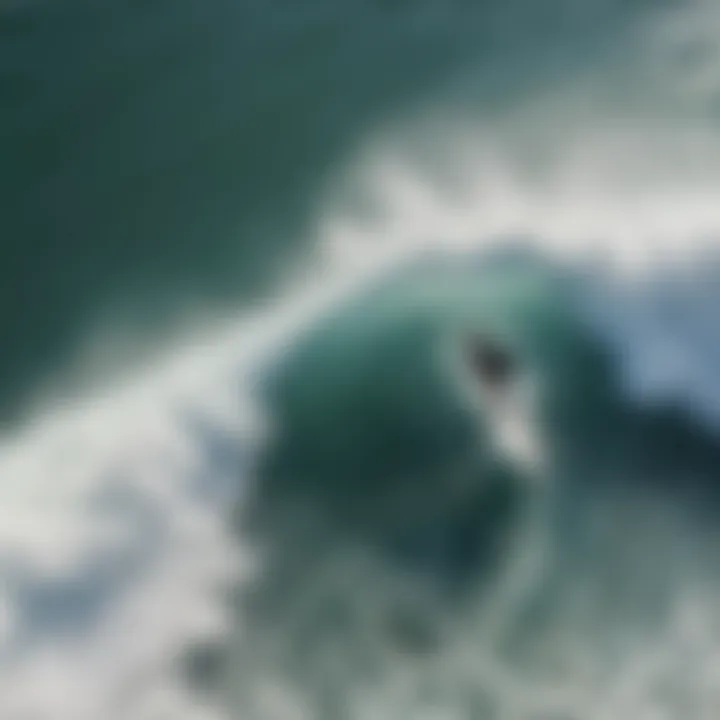
In summary, selecting the appropriate drones and accessories plays a pivotal role in the success of your surf films. Not only does it impact the technical quality of your footage, but it also shapes the overall narrative you aim to convey.
Legal and Ethical Considerations
Filming with drones has become increasingly prevalent among surfing enthusiasts who want to capture the waves from an elevated vantage point. However, there's more to it than just the thrill of flying a drone over the ocean. Legal and ethical considerations are crucial to ensure that this innovative technology is utilized responsibly. Ignoring these guidelines can lead to a variety of issues, from fines to a negative impact on wildlife and local surfers.
Understanding the legal framework surrounding drone usage helps protect both the user and the environment. This section sheds light on the regulations that govern drone filming, alongside the ethical implications that accompany aerial filming, particularly in sensitive coastal areas.
Regulations for Drone Use in Surfing
When venturing into the world of drone filming, being aware of regulations is essential. Not only do they help maintain safety, but they also promote respect within the surfing community. Let's break down two key aspects: the FAA Guidelines and Local Restrictions.
FAA Guidelines
The Federal Aviation Administration (FAA) has laid down specific drone regulations that apply nationwide. One of the standout elements of the FAA Guidelines is the requirement for drone registration for any UAV weighing over 0.55 pounds. This requirement not only contributes to safety but also allows authorities to maintain oversight of drone operations.
A notable aspect of these guidelines is that they enforce flight height restrictions, capping the altitude at 400 feet above ground level. This helps avoid collisions with manned aircraft and keeps the skies organized. Adhering to these guidelines is crucial; otherwise, operators may face hefty fines or even lose the privilege to operate drones altogether.
Another feature unique to FAA regulations is the line of sight requirement, mandating that pilots keep their drones within visual confirmation at all times. This stipulation improves safety: ensuring you can react swiftly to unforeseen circumstances. It's all about fostering a safe environment for both flying and surfing.
Local Restrictions
In addition to federal regulations, many localities impose additional restrictions specific to drone use, especially in areas frequented by surfers. These Local Restrictions might include designated no-fly zones, often implemented in popular surfing spots to preserve the tranquility and safety of both surfers and spectators.
A key characteristic of Local Restrictions is that they can vary significantly from one region to another. This localized approach can be beneficial, as it ensures that the specific needs of a community are respected. For example, in some coastal areas, local authorities may have banned drones during peak surfing hours or close to wildlife habitats to minimize disturbances.
However, the downside is that lack of awareness about these regulations can lead to unintended violations. Always checking the local laws before hitting the skies is imperative to avoid potential legal ramifications while enhancing the filming experience.
Respecting Privacy and Nature
Beyond legal aspects, respecting privacy and nature is paramount for ethical drone filming. Surfers, like everyone else, have a right to privacy; flying a drone overhead can infringe on that personal space. It’s essential to remain discreet, flying at reasonable distances and angles to avoid intruding on anyone's experience.
Equally important is being conscious of wildlife. Coastal areas are often home to diverse species, including nesting birds and marine life. Drones can disrupt these habitats, leading to stress for animals or even abandonment of nests. Operators should prioritize aerial filming techniques that minimize disturbances, such as avoiding areas known for wildlife activity during crucial times.
Ultimately, merging technology with respect for our surroundings can lead to artful representation of surf culture while fostering a harmonious relationship between surfers, filmmakers, and nature.
Techniques for Effective Surf Filming
When it comes to elevating the art of surf cinematography, employing the right techniques is paramount. The unique environment of the ocean, combined with the dynamic movements of surfers, presents both challenges and opportunities for drone operators. Having a solid grasp of effective filming techniques not only allows for capturing breathtaking footage but also enhances storytelling within the surf culture.
Utilizing drones provides an aerial perspective that can portray a sense of scale and context that ground-level filming often misses. This section delves into careful planning, execution, and post-filming movement mastery, helping enthusiasts create films that resonate deeply with viewers.
Planning Your Shoot
Timing and Location
Timing and location are the cornerstones of successful drone shoots, especially in the fast-paced world of surfing. Selecting the right time of day can make all the difference between mundane footage and stunning cinematics. Early mornings or late afternoons, often referred to as the golden hours, provide the best natural lighting, casting an ethereal glow on the water. Additionally, weather conditions play a critical role.
A clear day with light winds can reduce turbulence, ensuring smoother drone operation, while overcast skies might suppress vibrant colors but can soften harsh shadows on the surfers. Choosing popular surfing spots like Malibu Surfing Beach can also be advantageous due to the vibrant action of both the surfers and the scenery. However, these locations can attract numerous other drone operators, making it essential to scout less crowded spots if you're after something unique and personal.
Setting Up Shots
Setting up shots can be seen as an art form in itself. Carefully planning shot composition is crucial to highlight both the surfers and the surrounding environment. This might include deciding between wide shots that show the entire wave and smaller close-ups that capture the surfer's expression as they carve through the water. By blending aerial perspectives with ground-level interactions, filmmakers can create a rich visual narrative.
Moreover, utilizing techniques such as the 'rule of thirds' can enhance the overall aesthetic. Placing the horizon line at the top third or bottom third of the frame often yields visually pleasing results. While some might prefer a more spontaneous approach, it’s the meticulous planning that often pays off in compelling footage.
Mastering Flight and Camera Movements
Follow Shots
Follow shots are a shining star in the realm of action sports filming. This technique allows the drone to maintain a consistent distance from the surfer, capturing everything from their perspective as they glide across the water. The key characteristic of follow shots is their ability to convey speed and fluidity, allowing viewers to experience almost the same thrill as the surfer themselves. Unlike static shots, follow shots enhance engagement by immersing the audience in the moment.
However, achieving smooth follow shots requires excellent coordination between flight paths and surfer movements. Practicing patience and figuring out the ideal distance is essential, along with a good knowledge of the surfer's patterns to prevent any jerky motions in the footage. Though challenging, this setup can yield breathtaking results when done correctly.
Top-Down Perspectives
Top-down perspectives provide an interesting viewpoint that many might overlook. This method captures surfers from directly above, offering a unique view of the waves and the actions they perform. The beauty of this angle lies in its ability to present the symbiotic relationship between the surfer and the fluid dynamics of the sea.
One beneficial aspect of top-down filming is how it allows for broader shots that include the fullness of the environment, which can be excellent for context. However, it often demands different approaches concerning drone flight height and angle to avoid disturbing surfers below. Many times, it can create an artistic feel that enhances storytelling by visually framing the chaos of the ocean around focused action.
"Mastering these techniques can lift your surf films from amateur to something that resonates with both the surfing community and a broader audience."
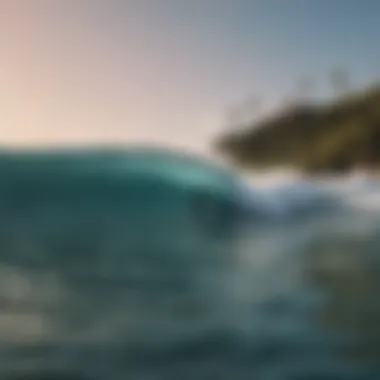
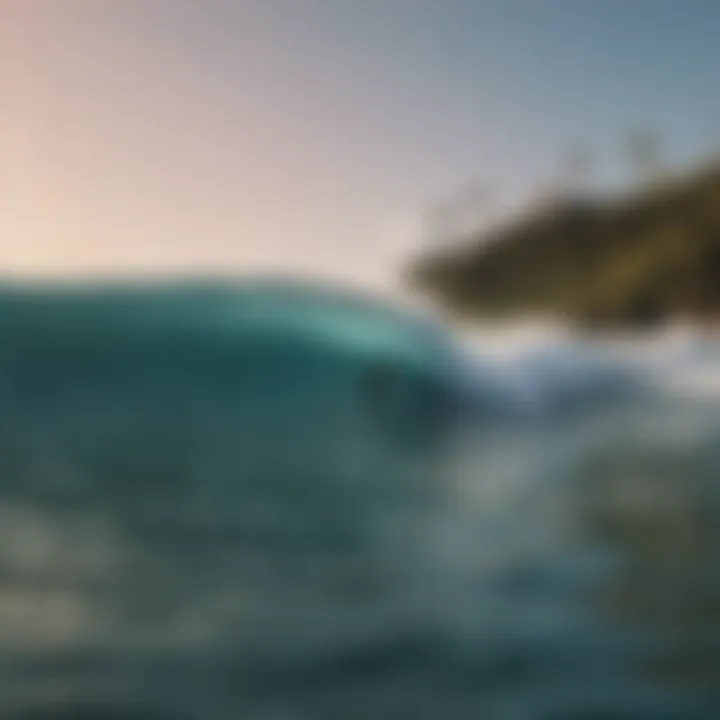
Post-Production Techniques
The magic of filming often doesn’t end with the click of a button; it continues in the editing bay. The post-production phase is where the raw footage captured by your drone transforms into a polished, engaging visual experience. For surfers wishing to showcase their sessions, understanding post-production is vital as it allows you to highlight not just the action, but the environment that surrounds it—everything from crashing waves to the sprawling coastline.
In this phase, you polish your footage, making it worthy of sharing. A well-edited piece can evoke emotions, tell a story, and capture the essence of surfing culture. Tutorials and learning are plentiful, making it possible for those who are not from a film background to pick up essential skills quickly.
Editing Software Options
Beginner-Friendly Tools
For those just dipping their toes into the water, beginner-friendly tools offer an excellent starting point. Software like iMovie or Adobe Premiere Rush is designed for ease of use. These programs allow beginners to play with their footage without feeling overwhelmed by countless features. Their intuitive interfaces make it easy to cut clips, adjust sound levels, and add basic transitions.
One prominent feature is their built-in tutorials, guiding users step-by-step. This characteristic significantly lowers the entry barrier for many aspiring filmmakers in the surfing community. However, while these tools are great for beginners, they may fall short when it comes to more advanced capabilities, especially for filmmakers aiming for professional quality.
Advanced Editing Software
On the other end of the spectrum sits advanced editing software such as Adobe Premiere Pro or DaVinci Resolve. These platforms offer a treasure trove of features, allowing for intricate color grading, detailed audio manipulation, and complex transitions. The level of control and precision provided can elevate surf films from a simple compilation of rides to a well-crafted narrative with depth.
The unique capability of advanced software lies in their extensive toolsets. Users can not only edit an entire film but also manage specific shots meticulously. However, this complexity can become a double-edged sword; the steep learning curve may deter newcomers to film editing.
Creating a Compelling Narrative
The Role of Music
Integrating music in a surf film is like adding the soul to an already lively body; it brings energy and rhythm to the visuals. The right soundtrack can turn an exhilarating ride into a legendary moment by syncing perfectly with the action. Music not only complements visuals but sets the emotional tone. For instance, an upbeat track can energize footage of surfers catching waves, while a more mellow tune can enhance serene moments captured at dawn.
Furthermore, using royalty-free music can be a smart choice for those sharing content online. Choosing tracks that align with the film's mood will make your work resonate with viewers, often leading to deeper emotional engagement.
Transitions and Effects
Transitions and effects are the fine details that can elevate a surf film from good to amazing. They can narrate the passage of time or show shifts between different locations, effectively tying the story together. Smooth transitions create a professional feel to your project. You might find a fade to black fitting after a big wipeout scene, setting the tone before moving to the next stunning shot.
In addition to aesthetic appeal, using effects can enhance the storytelling. However, it's essential to strike a balance, as overusing them could distract rather than engage the viewer. Remember, simplicity often leads to elegance in storytelling.
"The goal is to bring the audience to the spot, to feel the surf, not just see it."
Understanding post-production techniques, from choosing the right software to editing music and effects, is essential for surfers looking to share their aerial adventures. It bridges the gap between capturing the moment and creating an immersive experience.
Case Studies: Successful Drone Filming in Surfing
Exploring case studies of successful drone filming in surfing not only illustrates the art of capturing spectacular waves but also sheds light on the creative processes and techniques that shaped those visuals. By examining actual examples, enthusiasts can glean valuable insights about what makes drone footage effective, inspiring them to elevate their own practices in the field.
Notable Surf Films Featuring Drone Footage
Several surf films have made waves, quite literally, by integrating drone footage into their storytelling. These films highlight the unique perspectives and dynamic movements that drones can provide. For instance, "View From a Blue Moon" by Kai Lenny combines traditional filming techniques with breathtaking drone shots that deliver an unparalleled look at surf culture. The use of DJI Phantom drones in this film allows for stunning aerial views that not only showcase the action but also the mesmerizing beauty of the ocean.
Another noteworthy mention is "Momentum Generation", which dives into the lives of surfers from the 1990s. The filmmakers employed drones to capture the emotions and environments surrounding these legends. The drone work complements traditional shots, creating a seamless narrative that breathes life into the past. Drones add layers to the storytelling, illustrating how the surfers interact with both the waves and the natural landscape.
In addition, the "Under an Arctic Sky" documentary shifts the typical surf film paradigm. Primarily shot in Iceland, the filmmakers utilized drone technology to capture breathtaking visuals of surfers riding waves amidst stunning glacial backdrops. The ability of drones to navigate challenging environments not only enhances the visual appeal but also reflects the spirit of adventure inherent in surfing.
Lessons Learned from Filmmakers
Through these case studies, several insights emerge—lessons that those interested in surfing and drone filming can incorporate into their own projects:
- Pre-Shoot Planning: Successful filmmakers emphasize the importance of planning ahead. Understanding the wave conditions, sun movements, and the ideal time of day for shooting ensures that the footage can capture the best moments.
- Storytelling Through Aerial Perspectives: Drones allow filmmakers to tell stories from distinctive angles, revealing the relationship between surfers and their environment. This depth adds richness to the narrative that traditional filming sometimes misses.
- Technical Proficiency: It’s clear that being attuned to both drone operations and surf filmmaking techniques can dramatically enhance the output. Filmmakers emphasize mastering the technology behind the drones and understanding the physics of waves to create compelling scenes.
- Safety First: Filmmakers also stress the importance of safety. Navigating drones over water presents unique challenges. Ensuring that both the crew and the surfers are safe while capturing those thrilling shots is non-negotiable.
By learning from the experiences of others, aspiring drone operators can open doors to creativity and innovation, ultimately enhancing their own productions. The fusion of technology and artistry in surf films serves to inspire, guiding new filmmakers toward making waves of their own.
Future Trends in Drone Filming
As the world of surfing continually evolves, so too does the technology we use to capture its beauty and excitement. The future of drone filming is not just about improving the equipment we utilize, but also about preparing for the new ideas and practices that will soon make their way into this vibrant field. By addressing future trends in drone filming, filmmakers can stay ahead of the curve, crafting stunning visual experiences that reflect the essence of surfing. Understanding these trends can lead to better decision-making regarding equipment, techniques, and the overall storytelling process.
Advancements in Drone Technology
The rapid pace of technological advancements in drones is reshaping the landscape of aerial filming. Here are key elements to consider:
- Improved Camera Capabilities: Modern drones now feature high-resolution cameras capable of shooting in 4K and even 8K, allowing surfers to capture their rides in crystal-clear detail. Enhanced low-light performance is also making it possible to capture breathtaking dawn and dusk sessions.
- Automated Flight Modes: Many drones come with sophisticated programmed modes, such as follow-me mode, that allow for dynamic and fluid filming without the need for a pilot. This technology gives more freedom to filmmakers, letting them focus purely on creative expression.
- Obstacle Avoidance Systems: With these systems in place, drones can now fly in challenging environments, ensuring they maintain a safe distance from surfers and rocks, which is crucial for reducing risk during shoots.
"The key to effective drone filming is not just the technology itself but learning how to harness it safely and creatively."
Sustainable Filming Practices
As concern for the environment continues to grow, adopting sustainable practices in drone filming is becoming increasingly vital. This includes finding a balance between capturing breathtaking footage and preserving nature. Below are some practices to take to heart:
- Minimizing Noise Pollution: Drone technology is advancing towards quieter propulsion systems. Choosing such drones can greatly reduce disturbances to marine life and beachgoers alike, making film shoots more environmentally friendly.
- Staying Aware of Wildlife: Filmmakers should prioritize understanding the ecosystems they are working in. This involves avoiding flights near nesting birds or sensitive habitats to ensure that the natural environment remains undisturbed.
- Offsetting Carbon Footprint: Engaging in carbon offset programs, like planting trees or supporting marine conservation, helps mitigate the impact one may have on the planet. These actions showcase responsibility and can even resonate positively with audiences who value eco-friendly practices.
By embracing future trends in drone filming while remaining cognizant of our environmental responsibilities, surf filmmakers will not only enhance their storytelling capabilities but also contribute to the preservation of the surf culture and its vibrant surroundings.















